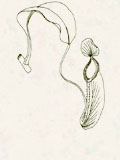
Miscellany (pdf)
| BBR 2004 | |
| Sham Chung: a revisit | |
| Big Fish Count 2004 | |
| Kadoorie Farm & Botanic Garden - Wildlife updates & sightings |
BBR 2004
by Fion Cheung (ENS Year 3 student)
After a long (18 hours), hard and tiring bird-watching trip, the Big Bird Race (BBR) 2004 was completed successfully yesterday (28/2) at dusk. This year, our group consisted of 11 Environmental Life Science final year students and many other groups were amazed by our combination .......all of us are girls!
As for last year's race, the bird-watching schedule was tight. Since this year's BBR began at midnight, we started walking around Kadoorie Agricultural Research Centre where we stayed for the night and then drove to Shek Wu Wai trying to record bird calls in the dark. It was windy and thus very difficult to detect the weak bird calls. Luckily, we were able to record the calls of a Collared Scops Owl and several Savanna Nightjars. After a short break, we set out again at about 6.30 to Pak Ngau Shek off Kadoorie Farm and then to Tai Po Kau. The number of birds recorded at Tai Po Kau was a little bit less than expected as a result of the windy morning and quite a lot of human disturbance (for example, cars of park-visitors). But then, our luck came back and the number of birds recorded surged in Sha Po, which is situated in North Kam Tin, and Mai Po. Just in Sha Po, we recorded nearly 40 bird species (Fig. 1). However, it was sad to learn that this wonderful bird paradise was under imminent threat of development and illegal landuse. Despite the fact that we have the Environmental Impact Assessment Ordinance (EIAO) to govern the impacts of development on our environment, the unacceptable impacts at Sha Po warrant thorough evaluation of the way the EIAO is used. While we were observing a Yellow-billed Grosbeak on a tree branch on the way out of Sha Po, our "angel", which was a handsome Hoopoe, suddenly came to visit us!! Every one of us was so excited by its sudden appearance that the poor little Grosbeak was put aside. When we arrived at Mai Po, it was sunny and so it was quite exhausting to watch birds there. Like many other groups, we could not spot any night herons in Mai Po so we went to A Chau to find them. Lastly, we reached the Little Egret Restaurant to finish the race (Fig. 2).
 |
| Fig. 1. Bird watching at Sha Po. |
We recorded 115 different bird species and ranked the 10 out of 13 groups this year. However, we won the Pentax Cup as we had the largest number of individual sponsors. The prize is six pairs of Pentax binoculars. We have to thank all those who supported the Birdbrains Team this year. One thing I can be sure is that we were all lucky girls as nearly half of us got a prize in the lucky draw!
 |
| Fig. 2. End point at the Little Egret Restaurant. |
Finally, I would like to express my gratitude to Dr Hau for his great effort in initiating our interest in bird-watching and organizing the Birdbrains Team for us this year. I must also thank Mr. Yu Yat Tung for his patience in teaching us the bird-watching skills. Mr. Yu is really an experienced bird-watcher and we are grateful to have him in our team. It was the second BBR for most of us to take part in and I am glad that Dr Hau said our bird-watching skills, especially on identifying bird calls, were better than last year. Although after graduation, there may be fewer chances for me to go bird-watching with my classmates, my interest in bird-watching will not fade and I do hope that my classmates and I can join the BBR again next year.
|
|
P.15-16 |
|
Porcupine! |
 Copyright © 2000 |
